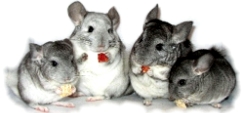
When chinchillas first go into labor, they usually flatten out on the bottom of the cage, their breathing is slightly labored then becomes more labored as time passes ... this is the early stage of labor.Later, they will do what looks almost like stretching exercises and pushing/pulling exercises, this is getting much closer to delivery time and mom is helping the kits get in the proper position for delivery.
Chinchillas normally deliver standing,
unless they are in trouble and/or it is a large litter and she's about worn out with the last 1 or 2 chins yet to be delivered.
I have never herd of a seizure lasting 7 hours, but nothing is impossible. When a chinchilla is having a seizure, normally, you will see the head draw backwards towards the back to the point you think it's neck is going to break, the legs and arms will stiffen and sometimes move erratically, the tail will often twirl furiously. The degrees of these actual motions will depend on the degree of intensity of the seizure.
A chinchilla can delay delivery 24 to 48 hours. She must have felt uncomfortable or felt something was wrong to try to delay the delivery. Animals have been given this special way of knowing when something is not quite right or a kit will not survive. Apparently, she was right, but delaying the delivery did not help what was wrong. If she is a first time mom, they will sometimes panic and try to delay the delivery. When this occurs, it is best to not leave them alone, stay there to comfort them, if in no other way, just by your presence there and a gentle soft voice.
For calcium to be distributed properly to the body, it needs to be in an acid environment ... Tums is an antiacid. Calfmanna and/or a cuttle bone are good for a calcium supplement. I think all pregnant and/or nursing females need the extra calcium.
The kit that died, the one with no eyes. Did you open the eye lids and there litterally were no eyes there, just empty sockets? I have known of preemies born with the eyes closed and if they are not made to open with in the first 24 to 36 hours, they will atrophy and disappear, but I have not known of one born with no eyes.
If the other kit was perfectly healthy, I would consider giving her one more chance to have another litter, but I think I would put her with a different mate. Sometimes the genetics of two particular chins will have a problem, where with different mates, the problem may never occur again. Remember, just because she carried them, the problem may not be with her genetics.
I would follow both the parents' future litters carefully. Should something similar happen again, I would take that chin out of breeding. A defect can come from either parent or a combination of two particular parents.
You will also want to watch their kits' litters (their grandkits). If it is genetic, it could possibly be passed on to future generations. If this is the case, this second kit can appear perfect, but still be carrying a defective gene. Should any future litters from this kit have the same problem occur, it, along with this pair of parents, should be taken out of breeding completely, in my opinion. Should you allow someone to adopt this one kit, I would let them know about the sibling, should it happen to this kit's future kits, they would be emotionally prepaired for the possible event. Personally, I would keep the kit and allow it to breed so that I would know first hand if a problem developed ... unless there is another kit born to either parent that has the same defect that the kit that died had. In that case, I would not allow this sibling kit to be put into breeding at all. If another kit is born with the same disability to either parent, I would assume and treat it like it has a hereditary defective gene and never put it into breeding.
Just my thoughts ... you have to decide how you want to handle the situation.


Jo Ann

 Author
Topic: Help!!! (Read 5946 times)
Author
Topic: Help!!! (Read 5946 times)




